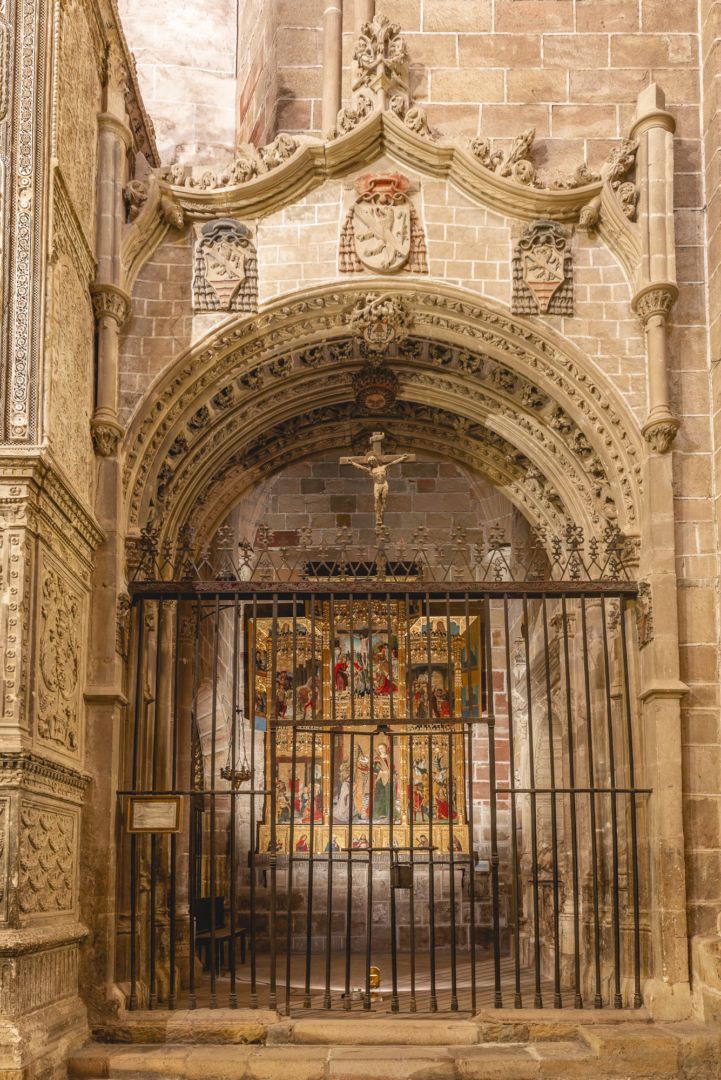T
his chapel was founded in 1515 by Fernando de Montemayor. Its front, which gives onto the aisle on the side of the Evangel, is unusual and interesting. It can be classified into the “Cisneros-Elizabethan» style, as it forms a unique, incredible mixture of the most extraordinary details with panels, mocarabs and elements of Mudéjar-Muslin art, as well as the Flamboyant Gothic.
In the lower section, on either side of the entranceway, are two magnificent sculptures representing Saint Michael and Saint James. The arch spandrels between Muslin interlacing arches are the coats of arms of the founder of the chapel. Above is a large frieze with interlacing drapery at either end. In the center is the Annunciation, with two figures. Between the two is ajar of Madonna lilies. AII this below magnificent Flamboyant Gothic arching’s.
Another frieze running above the coats of arms of the founder and of the Chapter. From this frieze springs a cornice of mocarabs with figures of lions at either end, crowned by filigree Flamboyant Gothic cresting, supporting in the center a Calvary
The interior of the chapel contains the Plateresque tombs of the founder, Fernando de Montemayor, and Bishop Eustaquio Nieto y Martín (1917 -1936), whose epitaph reads as follows: HIC IACET EXCMVS. AC RVOMVS. OR D.D. EUSTACHIVS NIETO ET MARTIN. EPISCOPVS SEGVNTINVS. IN OOIVM FIOEI SACRILGEGE OCCISVS DIE XXVII JULlI ANNI MCMXXXVI. The chapel al so has a painting on wood with a Renaissance frame, dating to the 16th century, by a Spanish author. The painting, with clearly Italian and Flemish influences, represents the Adoration of the Shepherds.
The interior is closed by a grille, the work of Juan Francés. The finial is similar to that of the Chapel of Los Arce, but is more gracefully executed. The bases are similar to all those found in the cathedral, with two particularities: the bars, twisted, are cut close to the end to make them quadrangular, as those in the Chapel of La Concepción by the Maestro Usón, and the central frieze is the only one of perforated plate found in the entire cathedral site.
Chaple of San Marcos y Santa Catalina de Alejandría
The wall of the front is decorated in Gothic style. The intrados of the arch, greatly ornamented, all so features Gothic and Plateresque decoration. The coats of arms of the founder (Juan Ruiz de Pelegrina) feature over the entrance.
In the interior of the chapel is the magnificent Gothic tomb of the founder, and a large triptych of the Castilian school, dating to the 16th century, and completed towards the year 1511. This is the most outstanding Gothic altarpiece in the entire cathedral, subject of a doctoral thesis on «15th- and 16th century pictorial painting techniques on panel». The altarpiece, dedicated to Saint Mark and Saint Catherine of Alexandria, is attributed to Antonio de Contreras (1496), whose name appears on the sword of Saint Catherine (possibly copied by a sword smith) in an inscription reading ANTONIVS I X XX O, who in 1496 painted the apse Chapel of San Agustín, now lost. The work allows us to study men’s headdresses in Castile during the last quarter of the 15th century, during the reign of the Catholic Monarchs: bonetes, carmeño/as, galotas, garvines, alharenes, almaizares, etc. It also offers us archaistic features regarding its relation to Spanish-Flemish art.

